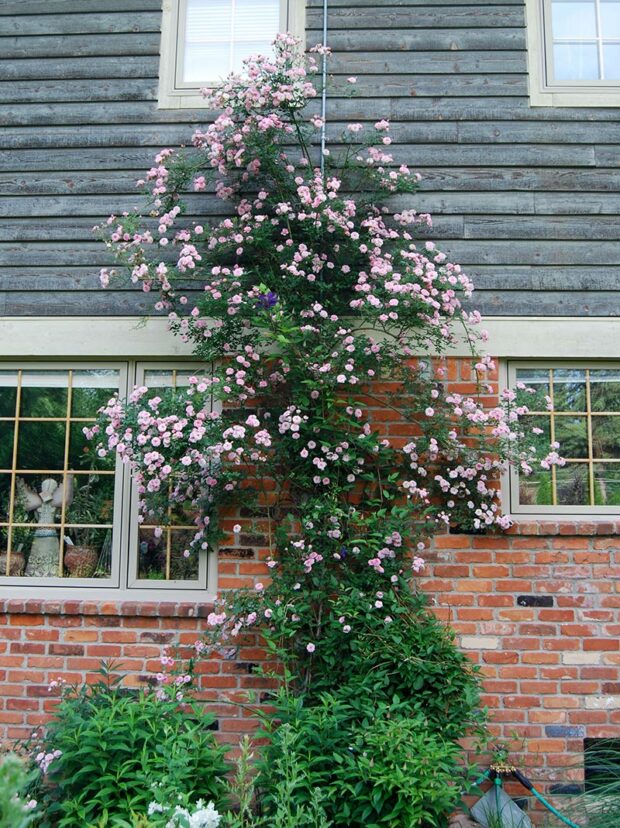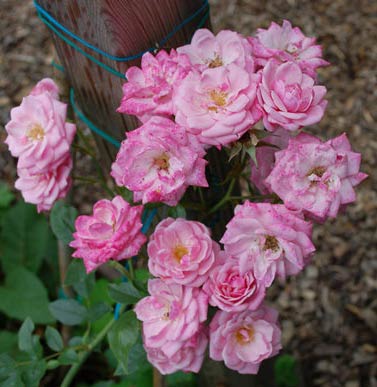The petunia is one of the most popular annual flowers to ever grace our gardens, porches and patios.
History
The petunias we know today are a far cry from those that first appeared in 19th century gardens, although they are all based mainly on two species that were discovered in South America in the mid-1700s and early 1800s: white-flowered Petunia axillaris and purple-flowered Petunia violacea. Introduced into Europe in the early 1800s, these species weren’t spectacular garden flowers—they were lanky and rather small-flowered—but breeders began crossing them in search of larger flowers and more colors, especially in Germany and England. The result was the garden petunia, referred to as Petunia x hybrida.
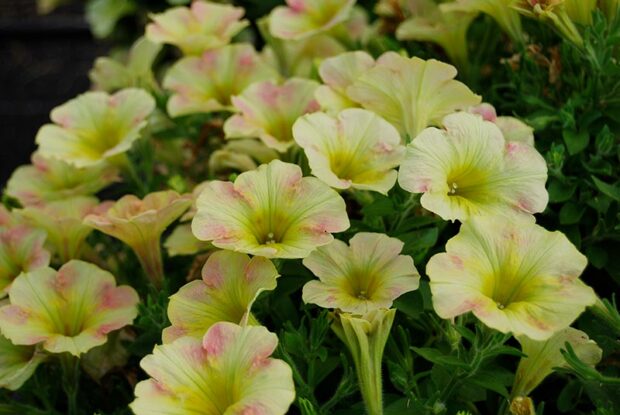
Types of petunias
Petunias are members of the nightshade family (Solanaceae), which includes relatives like tomatoes, peppers and tobacco plant (Nicotiana). Many of the different classes of petunias can be used interchangeably in the garden, but some are especially suited for containers and groundcovers. Many petunias have a light, sweet fragrance, particularly noticeable in blue petunias.
When buying plants, look for clean, green foliage—no dried out or spotted leaves, no powdery mold evident. The soil shouldn’t be water-logged. The plant should have buds as well as flowers.
Multiflora: This class performs better than most others in adverse weather conditions, especially hot, wet spells, during which they continue to flower freely. The flowers, which may be single or double, are produced in abundance all season. Single multifloras are ideal for mass and border plantings; double multifloras make spectacular container and window box plantings. Flowers range from 1-1/2 to 3 inches in diameter and come in a rainbow of colors, often with contrasting centers or stripes.
Grandiflora: The single-flowered grandiflora has long been a most popular petunia type. A sometimes sprawling plant, it is excellent for mass plantings and containers. The double-flowered grandiflora is the class that helped bring on “petunia mania.” Its 3- to 4-inch blooms look wonderful in porch or window boxes and large tubs. Both single- and double-flowered grandifloras come in numerous color variations, with cultivars that are solid or bicolor, deeply veined, striped or edged in a contrasting shade called picotee types. These petunias do best in cool temperatures; in high heat, the stems tend to stretch. Newer cultivars, though, are more compact and more rain- and disease-tolerant than many of the older ones.
Spreading: Low-growing plants that reach only 4 to 6 inches in height, spreading petunias can be used as a flowering groundcover, as well as a trailer in hanging baskets. Flowers, 2 to 3 inches wide, form along the entire length of each stem and are produced prolifically all season without the stems being trimmed back. Spreading petunias stand up particularly well to heat and humidity.
Floribunda: Available in single- and double-flowered hybrids, the floribunda petunia is basically an improved multiflora. Flowers are somewhat larger than those of a multiflora, but they’re produced with the same abundance. The plants flower earlier, like a grandiflora, but are more weather-tolerant—they perk up quickly after a rain shower. Floribundas are excellent for mass plantings in the landscape and for container plantings in pots and hanging baskets.
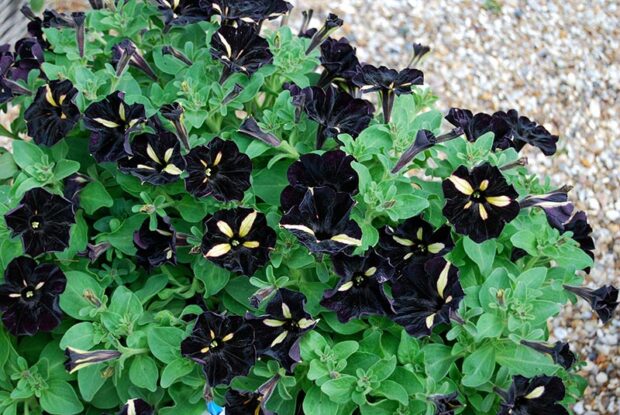
How to grow petunias
Petunias flourish in full sun (six or more hours of direct sun daily), but they will grow adequately in part shade. In part shade, the stems will stretch more, and the plants will flower less, but they will still add color to your landscape. If you are planting window boxes, remember that overhanging eaves will produce some shade and will also shelter the plants from rain—beneficial to blooms, but detrimental to the plants if you forget to water before they wilt.
Even though petunias are adaptable and will grow in almost any kind of soil (rocky, sandy or clay), they do best in a light but rich soil that has good drainage. When you have selected a site, amend the soil by digging in 1 to 2 inches of compost before planting. For planting in window boxes and containers, fill with a professional soilless potting mix, because it is lighter in weight.
Place the plants in the ground or in a container at the same level they were growing in the plastic pack. Follow the tag guidelines on spacing plants. In the ground, that can be anywhere from 6 to 20 inches apart, depending on the petunia type. Plants in containers are usually spaced closer together, so that the pots overflow with color. Consider the plant heights when placing them. Most petunias grow 12 to 14 inches high, but some can be slightly taller, while spreaders are typically only 6 inches high.
You may want to place a layer of mulch around plants in the ground to prevent mud from splattering up on the blooms. The mulch helps retain soil moisture and discourages weeds.
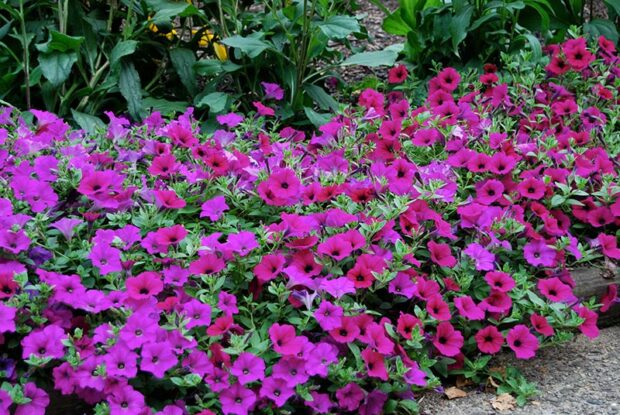
Maintenance
Petunias don’t require a lot of care, but they do benefit from some attention. Fertilize the plants monthly with a balanced fertilizer. The stems of most petunias have a tendency to stretch out by midsummer and bear fewer flowers, since blooms are formed at the ends of the stems. Prune them back quite severely so they will produce new shoots and more flowers. Trailing petunias don’t need to be pruned at all, which makes them really easy-care.
Because they are quite drought tolerant, in-ground petunias seldom need daily watering other than what they receive with rain. In prolonged drought periods, watch that the soil doesn’t get too dry. On the other hand, if you are growing the plants in window boxes or other containers, where soil can dry out quickly, check the soil daily in hot weather and water as needed.
Petunia cultivars are relatively disease resistant, but they occasionally can have a few problems. Plants in the garden can be bothered by white fly and flea beetles; the latter may eat holes in the leaves, the former is more of a nuisance than a dire threat. Avoid them, to some extent, by not growing petunias near other members of the Solanaceae family, especially tomatoes and potatoes.
Plants may droop after a hard rain. They will perk up within hours. Also note that petunias have naturally sticky leaves and stems, so don’t panic and think the condition is disease or pest related.
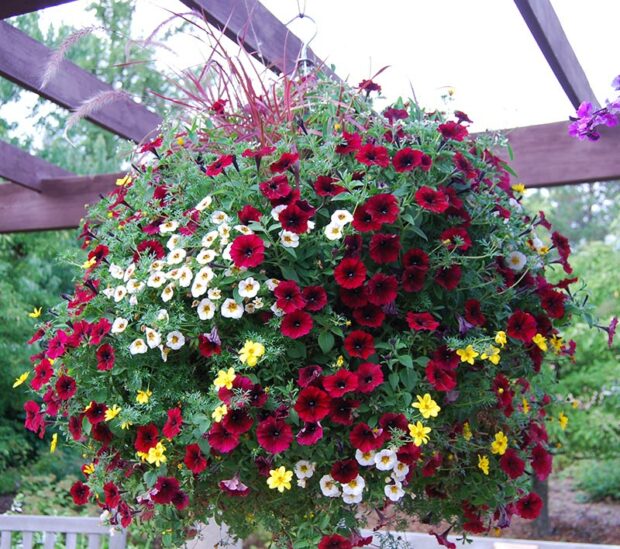
Gardening with petunias
Petunias have many uses in the landscape. Edge a perennial border with the more compact multifloras or floribundas. Plant them on the ends of vegetable beds, especially those that contain trellises of beans or cucumbers—they will fill the ground-level space with color that looks particularly attractive against the vegetables’ green foliage. Put petunias in mixed plantings in window boxes or in containers. The cascading or spreading types combine well with salvias and geraniums; grandifloras mix well with sweet alyssum, ivy-leaved geraniums and portulaca.
Petunias make excellent cut flowers; like pansies and zinnias, the more you cut, the more the plants seem to produce. Because their stems are somewhat lax and their leaves are sticky, the flowers are best cut with short stems. Place them in small vases or flower rings, where they will last for 4 to 6 days. As a cut flower, they may add fragrance to a room. Don’t use the blooms as an edible decoration, because the plants are toxic, as are many members of the nightshade family.
Whether you use petunias to edge a flower bed, cover a bare area as a groundcover, spill out of a container or trail from a hanging basket, this annual classic helps keep the garden colorful from late spring through fall.
By the National Garden Bureau.


